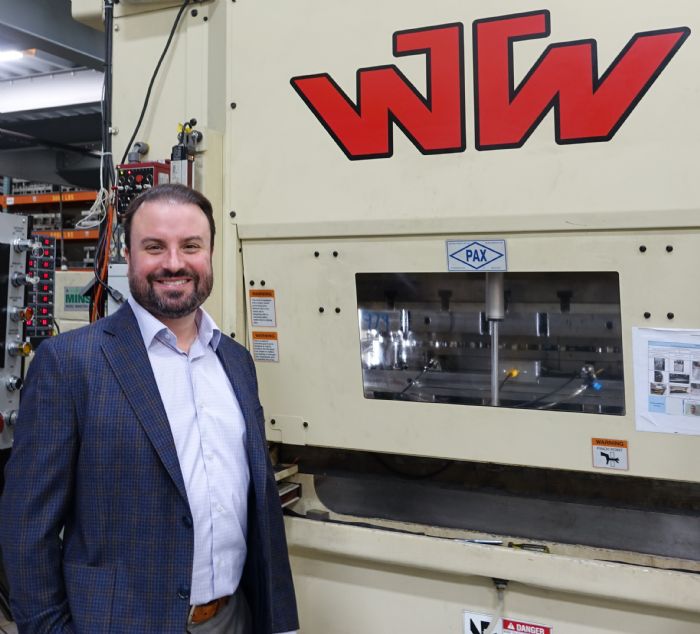Specifically, for WTW the group helped me identify a disinfectant fogger for cleaning the facility, which we’ve now used four times. My most meaningful contribution to the networking group during the pandemic probably was my experience and insights into securing the PPE loans.
Q: What is the biggest challenge you face as a company leader?
Wiegel: The biggest challenge we face, like most others, continues to be recruitment of the next generation of workers, made even more critical as WTW continues its growth spurt. While we continue to work with local high schools, colleges and manufacturing associations to market to new recruits the many advantages that manufacturing offers—and these efforts have been effective—our growth is outpacing the rate at which we can fill open positions.
I have at least 10 positions open and based on the work coming in I need to hire another 30 people at all levels in 2021. We’ve done a compensation analysis and we’re above market value. I want the best people, and since we’re running two shifts, our hourly rate is coming down, as are overhead expenses, which provides me with the budget to raise wages.
We’re also at the stage where it will be more important to find higher-skilled automation operators. We’ve got 21 robots and will have 30 by the end of the year. They work two shifts with no breaks—the equivalent of 60 people. We can take the labor savings realized by automation to help us pay our press operators more. It’s clear to me that we need to continue to reduce our manufacturing costs and transfer those savings to help attract, and also train, highly skilled people.
When we inherited the business from my father in 2011 we were in one facility at 48,000 sq ft. By 2012 we had two facilities and 93,000 sq. ft., and in 2017 and again in 2021 added new buildings. So, the good news is that we’re expanding quickly, but the bad news is that we’re piecemealing it. We do hope to consolidate everything under one roof soon, and plan to build a new 300,000- to 350,000-sq.-ft. facility. Last year we invested $13 million in capital equipment, and I have another $11 to 12 million I need to spend on equipment in 2021, and I currently don’t have the room. Most of this new investment is in value-added processes—welding and automation.
Q: What are two or three of the most important things you look for in a mid-level manager?
Wiegel: While every employee within the organization plays a significant role in our overall success, managers leading their respective teams can make or break our ability to succeed. WTW always has encouraged employees to work toward moving up the ladder and taking on new challenges, which includes management-level positions.
The obvious qualities that anyone looks for when searching
for a manager are intelligence and the required qualifications. However, I find that you cannot teach pride
and a drive for excellence. WTW offers
all of the training needed to become successful; however, what our managers do
with their acquired skills determines their outcome.
Secondly, WTW looks for proven problem solvers. Successful managers can identify problems and
offer up solutions, rather than asking for the help of others in higher-level
positions. The key to successful
managing: having problem solvers that are empowered with decision-making
authority.
Q: What are two things that you believe your company is doing well? What's one thing that you wish you could change?
Wiegel: Having a successful company does not come easy. As leaders, we face a lot of challenges, both planned and unexpected. However, a few key factors contribute to our growth and success.
First and foremost, our staff has the qualifications,
motivation and required training to ensure success. We empower them to make the necessary
decisions to move forward and allow us to work on the business rather than in
it. However, with that empowerment comes
responsibility, along with goals and metrics.
We will double our sales in the next 2 years, and triple in 4 years. I can’t manage that growth without having a team in place that I can lean on. An important lesson I’ve learned: I can’t work in the business anymore; I have to work on it. And for that to happen I must empower and trust the team. So, I am completely hands-off when it comes to our managers running their departments. It took me a long time to step away like this—I’ve been here 21 years.
In addition, a successful company cannot manage what it cannot measure. Having several metrics across the board, and to which we assign ownership, drives innovation and growth. Team leaders work together to develop the metrics and share them with staff. For example, we look at quoting and carefully rate our customers and prospects to prioritize the time we spend on quoting. We judge our engineering team based on time spent on programs vs. the time that we quoted. And we judge production based on OEE. Then we work with a detailed dashboard—without this, leaders would be driving success blindly.
One recent shining example of improved productivity came within
our team developing dies for our high-speed stamping department. We reallocated
two of the five die designers working on new tools and moved them onto the
production floor to troubleshoot and repair running tools. Before this move, we
felt like the design team faced constant interruption to address production
issues, and in some cases were putting Band-Aids on tools rather than
engineering out problems.
To continue improving, we’ll need to better manage our growth. We’re still a family-run business, and I think it may be time for us to develop and lean on a board of directors—high-level advisors that can challenge our strategic thinking and help with conflict resolution.
Q: How do you encourage and motivate your management team?
Wiegel: Encouraging and motivating the management team starts with being as honest and transparent as possible, setting the stage of where the company is and where we want to go. Each member of the management team represents one link in a strong chain.
With expectations set, managers must then oversee their own teams, which includes selecting their team members. In doing so, they take total ownership of their job scope and have a clear directive of what is expected and outlined by their goals and metrics. They’re essentially running a business within the business.
I read a lot of about Elon Musk and admire his innovation. From him I’ve learned that while you can have smart people in your company, if they lack the motivation and drive, they won’t do well.
Q: Can you provide an example of a solid management decision you made during the COVID-19 pandemic, and how it helped to address a major pandemic-related challenge?
Wiegel: Pledging to put the health and safety of our employees first, we started by setting up a text-messaging system to communicate directly to all employees. This helped address broad concerns and allowed us to take suggestions to create a safe and healthy working environment.
Then we invested in temperature-screening kiosks at all
employee-entry checkpoints at each facility.
These automated devices give a go/no-go to enter the building and send
emails to HR and management flagging anyone with a temperature out of range.
Additionally, we became proficient in Zoom, to allow qualified staff to work remotely. We assessed all of the people that could be productive remotely and asked our teams to continue to meet on a regular basis. Looking back on it now, I believe this process actually made the company more productive. Our meetings are very well-organized, and we require everyone to be on time and prepared. Many of our employees invested more hours into the company working remotely than working onsite. Personally, I worked more total hours in 2020 than in any year prior. MF
Technologies: Management
 This month we invite Aaron Wiegel, president of Wiegel Tool Works (WTW), to share his insights. WTW provides mass-production, progressive-die, heavy and high-speed metal stamping services, as well as engineering support, inhouse toolmaking, rapid prototyping, waterjet cutting and automated assembly. It operates from four manufacturing facilities totaling 207,000 sq. ft., including a 68,000 sq.-ft. headquarters facility and 25,000-sq.-ft. warehouse in Wood Dale, IL, a 52,000-sq.-ft. stamping plant in Bensenville, IL, and a new 62,000-sq.-ft. building in Elk Grove Village, IL, acquired in January 2021 for warehousing and distribution. It’s currently converting its existing warehouse into added production space for stamping and assembly operations.
This month we invite Aaron Wiegel, president of Wiegel Tool Works (WTW), to share his insights. WTW provides mass-production, progressive-die, heavy and high-speed metal stamping services, as well as engineering support, inhouse toolmaking, rapid prototyping, waterjet cutting and automated assembly. It operates from four manufacturing facilities totaling 207,000 sq. ft., including a 68,000 sq.-ft. headquarters facility and 25,000-sq.-ft. warehouse in Wood Dale, IL, a 52,000-sq.-ft. stamping plant in Bensenville, IL, and a new 62,000-sq.-ft. building in Elk Grove Village, IL, acquired in January 2021 for warehousing and distribution. It’s currently converting its existing warehouse into added production space for stamping and assembly operations. 








